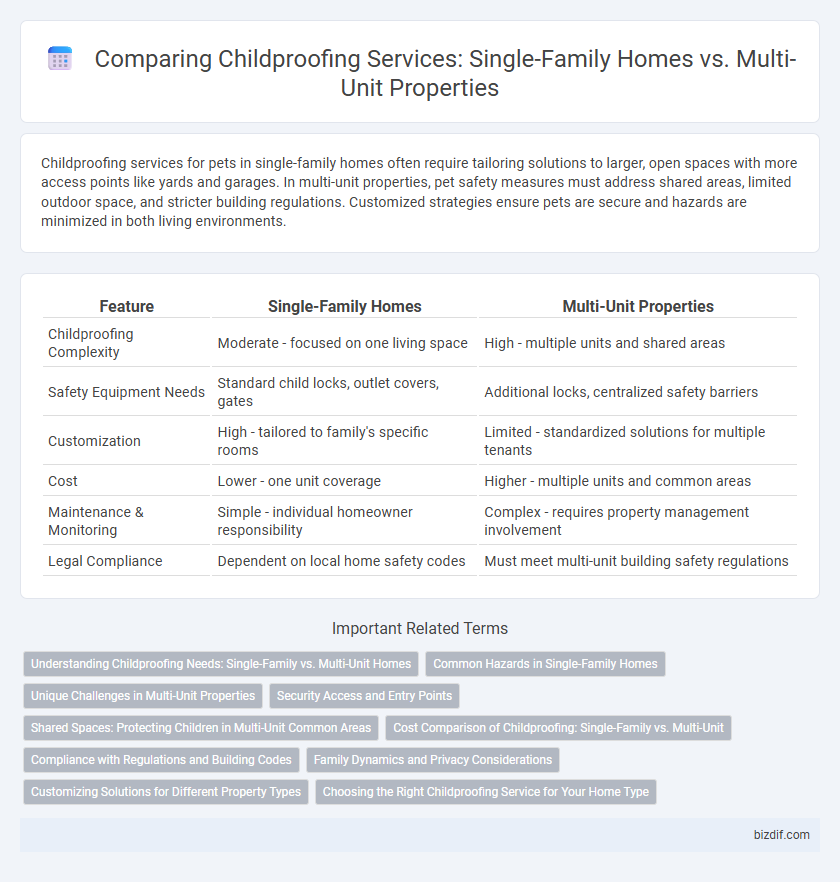Childproofing services for pets in single-family homes often require tailoring solutions to larger, open spaces with more access points like yards and garages. In multi-unit properties, pet safety measures must address shared areas, limited outdoor space, and stricter building regulations. Customized strategies ensure pets are secure and hazards are minimized in both living environments.
Table of Comparison
| Feature | Single-Family Homes | Multi-Unit Properties |
|---|---|---|
| Childproofing Complexity | Moderate - focused on one living space | High - multiple units and shared areas |
| Safety Equipment Needs | Standard child locks, outlet covers, gates | Additional locks, centralized safety barriers |
| Customization | High - tailored to family's specific rooms | Limited - standardized solutions for multiple tenants |
| Cost | Lower - one unit coverage | Higher - multiple units and common areas |
| Maintenance & Monitoring | Simple - individual homeowner responsibility | Complex - requires property management involvement |
| Legal Compliance | Dependent on local home safety codes | Must meet multi-unit building safety regulations |
Understanding Childproofing Needs: Single-Family vs. Multi-Unit Homes
Single-family homes typically require customized childproofing solutions due to larger indoor and outdoor spaces, including staircases, yards, and garages, which pose unique safety risks. Multi-unit properties often demand compact, modular childproofing approaches focusing on common areas, entry points, and shared facilities to ensure consistent safety for all residents. Understanding these distinctions allows for tailored childproofing strategies that address specific hazards inherent to each property type.
Common Hazards in Single-Family Homes
Single-family homes often present unique childproofing challenges such as accessible staircases, unsecured cabinets containing cleaning supplies, and exposed electrical outlets. Common hazards include open fireplaces, pools without fencing, and yard tools left within reach, increasing the risk of injury. Proper installation of safety gates, outlet covers, and secure locks on cabinets is essential to mitigate these risks in single-family residences.
Unique Challenges in Multi-Unit Properties
Multi-unit properties present unique childproofing challenges due to shared common areas, multiple entry points, and varying levels of control over neighbors' spaces, increasing potential risks for children. Unlike single-family homes, these environments require coordinated safety measures such as secure stair gates, locked community access points, and durable window guards compliant with local safety regulations. Property managers must implement consistent childproofing protocols across units to effectively mitigate hazards in these complex residential settings.
Security Access and Entry Points
Single-family homes offer straightforward security with fewer access points, making childproofing entry doors and windows more manageable. Multi-unit properties require comprehensive control of shared entryways, stairwells, and common areas to ensure child safety across multiple access points. Effective childproofing services in multi-unit buildings prioritize secure locks, monitored entry systems, and restricted access zones to prevent unauthorized or unsupervised child access.
Shared Spaces: Protecting Children in Multi-Unit Common Areas
Shared spaces in multi-unit properties require specialized childproofing measures to ensure safety in common areas such as lobbies, stairwells, and playgrounds. Installing secure gates, childproof locks on doors, and cushioned corner guards reduces the risk of accidents in these high-traffic zones. Regular inspections and maintenance of shared equipment and surfaces also play a crucial role in protecting children in multi-family housing environments.
Cost Comparison of Childproofing: Single-Family vs. Multi-Unit
Childproofing single-family homes typically involves higher upfront costs due to larger spaces, more rooms, and various entry points requiring safety measures. Multi-unit properties often benefit from standardized layouts, allowing for bulk purchasing and streamlined installation, which can reduce overall expenses. Budgeting for childproofing in multi-unit buildings may be more cost-effective per unit but still requires consideration of shared common areas and potential tenant turnover.
Compliance with Regulations and Building Codes
Childproofing services for single-family homes typically align with local residential safety codes, which often have straightforward requirements due to the property's standalone nature. Multi-unit properties must comply with more complex building codes and regulations, including fire safety measures, common area restrictions, and accessibility standards mandated by local housing authorities. Ensuring compliance in multi-unit dwellings requires detailed coordination with property management and adherence to state and federal regulations such as the ADA and NFPA guidelines.
Family Dynamics and Privacy Considerations
Single-family homes offer greater privacy and control over childproofing measures, making it easier to tailor safety solutions to unique family dynamics. Multi-unit properties require consideration of shared spaces and communal safety protocols to protect children across multiple households. Effective childproofing in both settings involves balancing privacy needs with consistent safety standards to ensure a secure environment for all residents.
Customizing Solutions for Different Property Types
Childproofing services tailor safety measures to suit the unique layouts and hazards of single-family homes, emphasizing customized solutions such as stair gates, outlet covers, and cabinet locks designed for individual rooms and open floor plans. In multi-unit properties, providers address shared spaces, entryways, and proximity-related risks by implementing scalable safety installations that comply with building regulations and accommodate multiple families' needs. Customized childproofing ensures optimal protection by adapting strategies to the structural differences and usage patterns of each property type.
Choosing the Right Childproofing Service for Your Home Type
Choosing the right childproofing service depends on whether you live in a single-family home or a multi-unit property, as each requires tailored safety solutions. Single-family homes often need extensive coverage for larger, varied spaces such as yards and staircases, whereas multi-unit properties demand specialized options for shared hallways and entrances. Expert childproofing services assess property layout and family needs to implement effective safety measures specific to the home type, ensuring comprehensive child protection.
Single-family homes vs Multi-unit properties Infographic

 bizdif.com
bizdif.com